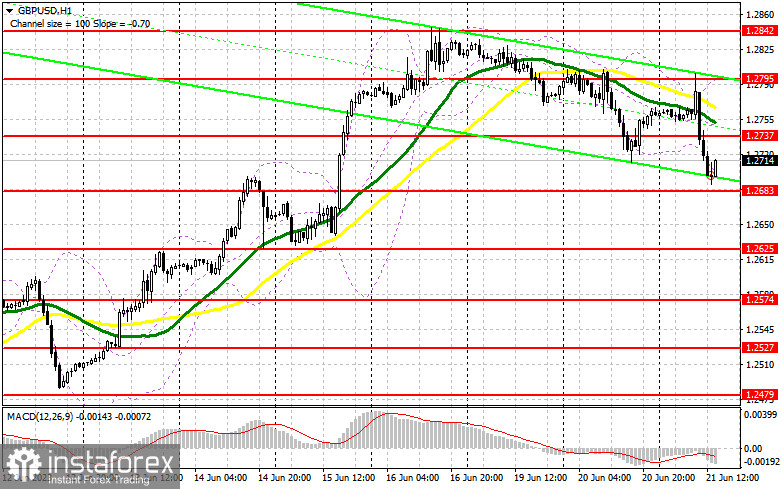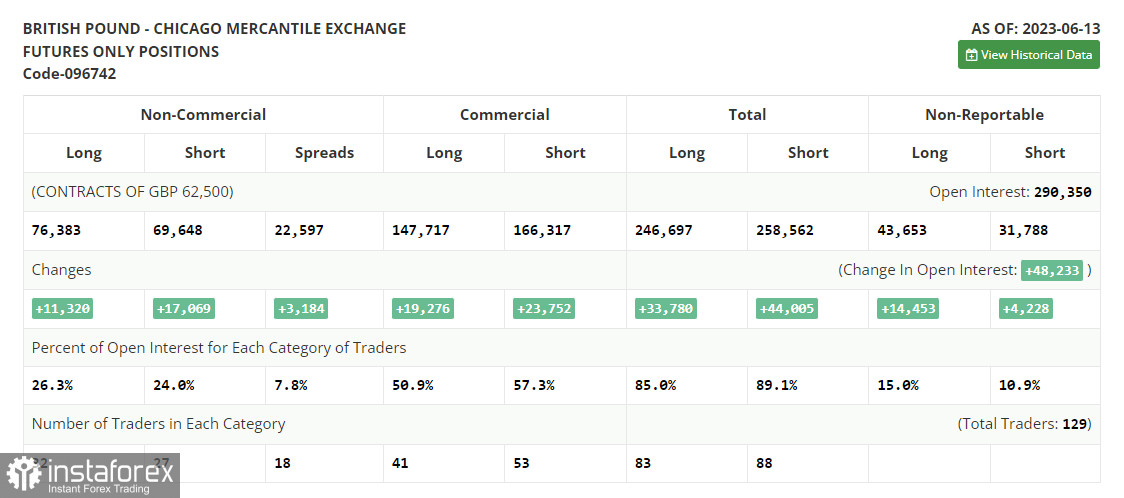In my morning forecast, I highlighted the key level of 1.2795 and recommended making trading decisions with this level in mind. Let us take a look at the 5-minute chart and analyze what happened. The pound sterling experienced a rapid decline, triggered by a false breakout at the aforementioned level, resulting in a substantial drop of over 90 pips. Throughout the latter half of the day, the technical situation remained relatively unchanged.

When to open long positions on GBP/USD:
Undoubtedly, bullish traders will seize the opportunity to buy the pound on dips, particularly in light of the news indicating that inflation in the UK has remains at its peak, with the Bank of England unable to address the situation at present. Market participants are speculating that the central bank might even raise interest rates by 50 basis points during tomorrow's meeting. Adding to the intraday volatility, we await the remarks of the Federal Reserve Chair, whose dovish tone could provoke a sharp upward surge in GBP/USD.
If sellside pressure on the pair persists in the latter part of the day, my strategy will focus solely on a false breakout around the nearest support level of 1.2683, which the pair narrowly eluded during the European trading session. A successful false breakout of that level would present an opportune entry point for establishing or expanding long positions, with an initial target at 1.2737. Moreover, key moving averages around that level favor the bears. A subsequent breakout and retest of this range would diminish the prospects for bears, providing an additional buy signal and setting the stage for a potential move towards 1.2795. The most distant target lies within the zone around 1.2842, where I will take profits.
However, in the event of a decline towards 1.2683 and a lack of buying activity following Powell's speech, downward pressure on the pound sterling will persist. Under such circumstances, attention would shift to the defense of the subsequent support zone near 1.2625, with a false breakout of that level serving as a trigger for opening long positions. I plan to buy GBP/USD immediately if it bounces off 1.2574, targeting an intraday correction of 30-35 pips.
When to open short positions on GBP/USD:
Sellers have been relentless in exerting downward pressure on GBP. While trading remains below the critical level of 1.2737, the downward correction will likely continue. A successful false breakout of this level, in the event of GBP/USD rebounding following Powell's speech, would create an optimal entry point for short positions, triggering a substantial sell-off towards 1.2683. Moreover, a subsequent breakout and an upward retest of this range would intensify the blow dealt to bulls, bolstering downward momentum and forming a sell signal with a projected decline towards 1.2625. The most distant target lies within the vicinity of the key level at 1.2574, where I will take profits.

If GBP/USD rallies amid limited activity near 1.2737, particularly after the release of UK inflation data and considering the prospects of tomorrow's Bank of England meeting, the bears might face imminent exhaustion. This scenario would enable the bulls to regain control, striving to retest local highs. In such a scenario, I would postpone opening short positions until the pair tests the resistance at 1.2795, a level where the pair has experienced significant downward pressure earlier today. A successful false breakout at that level would present an opportune entry for short positions. Nevertheless, if downward movement fails to occur, I will consider selling GBP/USD immediately on a rebound from 1.2842, targeting a corrective move of 30-35 pips intraday.
Commitment of Traders (COT) report:
The Commitment of Traders (COT) report for June 13 showed that both long and short positions increased sharply. The pound sterling has risen significantly recently, attracting the attention of bears. However, the aggressive policy of the Bank of England and the latest inflation data in the UK are bringing new bulls into the market, who are expecting further interest rate hikes. The fact that the Federal Reserve has paused its tightening cycle while the Bank of England has no plans to do so makes GBP quite attractive. The latest COT report states that short non-commercial positions increased by 17,069 to 69,648, while long non-commercial positions jumped by 11,320 to 76,383. The non-commercial net position decreased to 6,736 from 12,454 in the previous week. The weekly price rose to 1.2605 from 1.2434.

Indicator signals:
Moving Averages
Trading is taking slightly below the 30-day and 50-day moving averages, indicating continuing pressure on the pair.
Note: The period and price of the moving averages considered by the author are on the hourly chart (H1) and differ from the general definition of classical daily moving averages on the daily chart (D1).
Bollinger Bands
If GBP/USD declines, the lower boundary of the indicator at 1.2705 will provide support.
Description of indicators
Moving average (moving average, determines the current trend by smoothing out volatility and noise). Period 50. It is marked yellow on the chart. Moving average (moving average, determines the current trend by smoothing out volatility and noise). Period 30. It is marked green on the chart. MACD indicator (Moving Average Convergence/Divergence - convergence/divergence of moving averages) Quick EMA period 12. Slow EMA period to 26. SMA period 9 Bollinger Bands (Bollinger Bands). Period 20 Non-commercial speculative traders, such as individual traders, hedge funds, and large institutions that use the futures market for speculative purposes and meet certain requirements. Long non-commercial positions represent the total long open position of non-commercial traders. Short non-commercial positions represent the total short open position of non-commercial traders. Total non-commercial net position is the difference between the short and long positions of non-commercial traders.




















